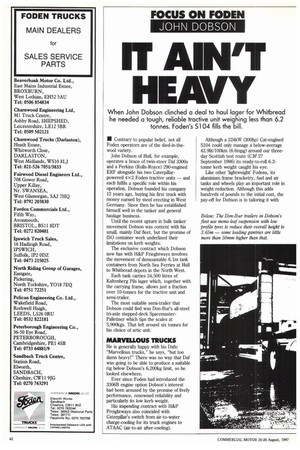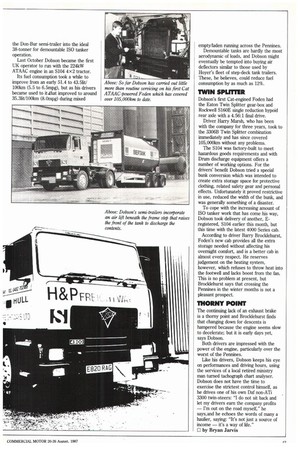IT AIN'T HEAVY
Page 44

Page 45

If you've noticed an error in this article please click here to report it so we can fix it.
When John Dobson clinched a deal to haul lager for Whitbread he needed a tough, reliable tractive unit weighing less than 6.2 tonnes. Foden's S104 fills the bill.
• Contrary to popular belief, not all Foden operators are of the died-in-thewool variety.
John Dobson of Hull, for example, operates a brace of twin-steer Daf 3300s and a Perkins (Rolls-Royce) 290-engined ERF alongside his two Caterpillarpowered 4 x2 Foden tractive units — and each fulfils a specific role within his operation. Dobson founded his company 12 years ago, buying his first truck with money earned by steel erecting in West Germany. Since then he has established himself well in the tanker and general haulage business.
Until the recent upturn in bulk tanker movement Dobson was content with his small, mainly Daf fleet, but the promise of ISO container work underlined their limitations on kerb weights.
The exclusive contract which Dobson now has with H&P Friegbtways involves the movement of demountable 6.1m tank containers from North Sea Ferries at Hull to Whitbread depots in the North West.
Each tank carries 24,500 litres of Kaltenberg Pils lager which, together with the carrying frame, allows just a fraction over 10-tonnes for the tractive unit and semi-trailer.
The most suitable semi-trailer that Dobson could find was Don-Bur's all-steel tri-axle stepped-deck SpacemasterPalletiser which tips the scales at 3,900kgs. That left around six tonnes for his choice of artic unit.
MARVELLOUS TRUCKS
He is generally happy with his Dafs: "Marvellous trucks," he says, "but too damn heavy!" There was no way that Daf was going to be able to produce a suitable rig below Dobson's 6,200kg limit, so he looked elsewhere.
Ever since Foden had introduced the 3306B engine option Dobson's interest had been aroused by the promise of lively performance, renowned reliability and particularly its low kerb weight.
His impending contract with H&P Freightways also coincided with Caterpillar's switch from air-to-water charge-cooling for its truck engines to ATAAC (air-to-air after-cooling). Although a 224kW (300hp) Cat-engined S104 could only manage a below-average 42.91ft/100km (6.6mpg) around our threeday Scottish test route (CM 27 September 1986) its ready-to-roll 6.2tonne kerb weight caught his eye.
Like other 'lightweight' Fodens, its aluminium frame bracketry, fuel and air tanks and wheels play an important role in weight reduction. Although this adds hundreds of pounds to the initial cost, the pay-off for Dobson is in tailoring it with the Don-Bur semi-trailer into the ideal 38-tomer for demountable ISO tanker operation.
Last October Dobson became the first UK operator to run with the 224kW ATAAC engine in an S104 4x2 tractor.
Its fuel consumption took a while to improve from an early 51.4 to 43.5Iit/ 100krn (5.5 to 6.5mpg), but as his drivers became used to it that improved to around 35.31it/100km (8.0mpg) during mixed empty/laden running across the Pennines.
Demountable tanks are hardly the most aerodynamic of loads, and Dobson might eventually be tempted into buying air deflectors similar to those used by Hoyer's fleet of step-deck tank trailers. These, he believes, could reduce fuel consumption by as much as 12%.
TWIN SPUTTER
Dobson's first Cat-engined Foden had the Eaton Twin Splitter gear-box and Rockwell S160E single reduction hypoid rear axle with a 4.56:1 final drive.
Driver Harry Marsh, who has been with the company for three years, took to the 3306B Twin Splitter combination immediately and has since covered 105,000km without any problems.
The S104 was factory-built to meet hazardous goods requirements and with Drum discharge equipment offers a number of working options. For the drivers' benefit Dobson tried a special bunk conversion which was intended to create extra storage space for protective clothing, related safety gear and personal effects. Unfortunately it proved restrictive in use, reduced the width of the bunk, and was generally something of a disaster.
To cope with the increasing amount of ISO tanker work that has come his way, Dobson took delivery of another, Eregistered, S104 earlier this month, but this time with the latest 4000 Series cab.
According to driver Barry Brocklehurst, Foden's new cab provides all the extra storage needed without affecting his overnight comfort, and is a better cab in almost every respect. He reserves judgement on the heating system, however, which refuses to throw heat into the footwell and lacks boost from the fan. This is no problem at present, but Brocklehurst says that crossing the Pennines in the winter months is not a pleasant prospect_
THORNY POINT
The continuing lack of an exhaust brake is a thorny point and Brocklehurst finds that changing down for descents is hampered because the engine seems slow to decelerate; but it is early days yet, says Dobson.
Both drivers are impressed with the power of the engine, particularly over the worst of the Pennines.
Like his drivers, Dobson keeps his eye on performances and driving hours, using the services of a local retired ministry man turned tachograph chart analyser. Dobson does not have the time to exercise the strictest control himself, as he drives one of his own Daf non-ATi 3300 twin-steers: "I do not sit back and let my drivers earn the company profits — I'm out on the road myself," he says,and he echoes the words of many a haulier, saying: "It's not just a source of income — it's a way of life." o by Bryan Jarvis




















































































